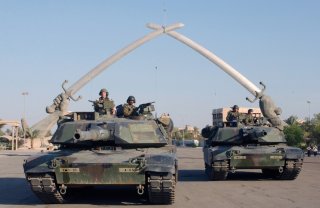In Ukraine and Syria, Alluring ‘False Flags’ Demand Strategic Skepticism
In the twenty-first century, we have seen multiple examples of “false flags” exploited in the interest of war.
In February of 2022, a new probable Jenkin’s Ear materialized—but this time targeting media consumers in Russia. Immediately before the Russian invasion of Ukraine, the breakaway “Donetsk People’s Republic” in eastern Ukraine claimed three people had been killed by a bomb while driving. This event was touted in the Russian media as proof that the people in Donetsk and Luhansk needed protection from the Russian military against an imminent assault by the Ukrainian armed forces. However, upon further investigation, it now appears that most likely the bodies depicted as being victims of the attack were in fact cadavers appropriated from a local morgue and staged for the purpose of framing Ukraine—a textbook “false flag” operation.
Nevertheless, Russia moved to recognize the breakaway republics immediately and then invaded Ukraine. Once again, and as in the Syrian example, the behavior Russia attributed to Ukraine made little sense, as a full-out assault on Donetsk—something Kiev had refrained from during eight years of simmering low-level conflict—always carried the risk of massive retaliation from the more powerful Russia. In short, Kiev, like Damascus before it, lacked a plausible motive to unilaterally escalate given its circumstances. Moscow, meanwhile, having already decided to invade by all accounts, certainly had a motive. Ironically, taking a page from the NATO alliance’s playbook in light of its interventions in the Middle East, the Russians justified their military escalation to their own people by citing the prevention of a looming humanitarian disaster. And much like those prior interventions, the current Russian military operations in Ukraine are creating a far worse humanitarian crisis than any the Kremlin professed to alleviate.
Waking up to the deception underlying the spectacle—of certain lawmakers and media outlets working in tandem to pass around a Jenkin’s Ear to redirect public discourse toward a controlled narrative and preset decision—begins by questioning whether the accused party reasonably benefits from the alleged action they undertook, i.e., to engage in a simple cost-benefit analysis about the strategic goals of the “perpetrators.” Or, to consider the question of timing as reflected in the original case: Jenkins, for instance, had lost his ear to a Spanish captain, eight years before it became relevant to those taking up his cause. In the case of the Mukden Incident, the event was entirely staged by the very people claiming to be responding to it in order to force unanimity around the decision.
More recently, the Jenkin’s Ear model seems to have evolved to include more third parties working, either together with their allies in the state or by themselves, to stage events that would “necessitate” a response from the policymakers in powerful countries. The purpose behind the semblance, however, remains more or less the same: to deflect skepticism and create a narrative where a more powerful state can justify and rationalize its military aggression against a weaker opponent.
The controversy around the fires at Ukrainian power plants—i.e., where each side blamed the other for this potentially catastrophic danger—is a microcosm of the importance of propaganda and information warfare in modern warmaking. Indeed, the competing narratives lead to recrimination and generate moral outrage which further rationalize, moralize, and aggravate the war. Both sides seek to promote their version of events to justify their military engagement and preemptively explain the eventual escalation.
As the world becomes more multipolar, those watching conflict zones would be wise to retain a critical attitude toward all parties in the conflict. Keeping the Jenkin’s Ear controversy in mind offers a good guidepost and model for processing the information coming out of conflict zones amid contested media narratives. The “fog of war” means that battlefield commanders might have to react rapidly with incomplete information, but external observers should prize their distance to acquire a proper perspective through the fog before jumping to any definite conclusions.
Christopher Mott is a Research Fellow at the Institute for Peace & Diplomacy. Dr. Mott is an international relations scholar and author of The Formless Empire: A Short History of Diplomacy and Warfare in Central Asia.
Image: Reuters.

